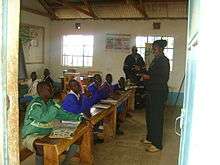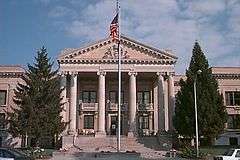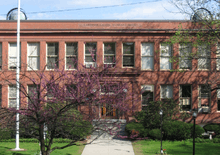Deaf education

Deaf education is the education of students with a variety of hearing levels which addresses their differences and individual needs. This process involves individually-planned, systematically-monitored teaching methods, adaptive materials, accessible settings and other interventions designed to help students achieve a higher level of self-sufficiency and success in the school and community than they would achieve with a typical classroom education. A number of countries focus on training teachers to teach deaf students with a variety of approaches and have organizations to aid deaf students.
Identifying deaf students
Children may be identified as candidates for deaf education from their audiogram or medical history. Hearing loss is generally described as slight, mild, moderate, severe, or profound, depending upon how well a person can hear the intensities of frequencies.[1]
Individual needs
Deaf education programs must be customized to each student's needs, and deaf educators provide a continuum of services to deaf students based on individual needs.[2] In the United States, Canada and the UK, education professionals use the acronym IEP when referring to a student’s individualized education plan.
Methods
Schools use a number of approaches to provide deaf-educational services to identified students. These may be grouped into four categories, according to whether (and how much) the deaf student has contact with non-deaf students (using North American terminology):
- Inclusion: Deaf students spend all, or most, of the school day with non-deaf students. Since inclusion requires considerable curriculum modification, it is considered best practice only for mildly-to-moderately deaf students.[3][4] Specialized services may be provided inside or outside the regular classroom, and students may leave the regular classroom to attend smaller, intensive instructional sessions in a resource room or to receive other services requiring specialized equipment or which might be disruptive to the rest of the class (such as speech and language therapy).[5]
- Mainstreaming refers to the education of deaf students in classes with non-deaf students for specified time periods, based on the deaf students' skills; deaf students learn in separate classes for the remainder of the school day.[6]
- Segregation (in a separate classroom or school): In this model, deaf students spend no time in non-deaf classes or with non-deaf students. Segregated students may attend a school where non-deaf classes are provided, but spend their time in a separate classroom for students with special needs. If their special-needs class is in a mainstream school, they may have opportunities for social integration (for example, eating meals with non-deaf students);[7] alternatively, deaf students may attend a special school.[6]
- Exclusion: A student unable to receive instruction in any school is excluded from school. Most deaf students have historically been excluded from school,[8] and exclusion may still occur where there is no legal mandate for special-education services (such as developing countries). It may also occur when a student is in hospital or housebound.[6] Excluded students may receive individual or group instruction, and students who have been suspended or expelled are not considered "excluded" in this sense.
Bilingual-bicultural education

In this method, deafness is approached as a cultural, not a medical, issue.[9] In a bilingual-bicultural program, deaf children are recommended to learn American Sign Language (ASL) as a first language, followed by written or spoken English as a second language.[9][10] Bilingual-bicultural programs consider English and ASL equal languages, helping children develop age-appropriate fluency in both.[10] The bilingual-bicultural approach believes that since deaf children learn visually, rather than by ear,[9] classes should be conducted in a visual language. To avoid harming the students' accuracy and fluency in either language, American Sign Language and spoken English are not used simultaneously, since they use different grammar, syntax, and vocabulary; ASL is usually used as the language of instruction, though some bilingual-bicultural schools use spoken English in some contexts with some students. Many bilingual-bicultural schools have dormitories; students may either commute to school or stay in a dormitory as part of a residential program, visiting their families on weekends, holidays and school vacations.
Auditory-oral and auditory-verbal education

The auditory-oral and auditory-verbal methods, known collectively as listening and spoken language, are forms of oral education.[11] These methods are based on the belief that a deaf child can learn to listen and speak so that their family does not need to learn sign language or cued speech.[12][13] These methods, presented as communication options, rely on parental involvement.[12][13] Children using this option may be placed in a continuum of educational placement, including oral schools (such as the Clarke Schools for Hearing and Speech), classrooms for deaf students in public schools or mainstream classrooms with hearing students.[12][13][14]
Simultaneous or Total Communication
There is great variety in programs that label themselves as using simultaneous communication or total communication. Most often these programs do not use a grammatically correct form of either English or American sign language. Rather, professionals use a mixture of oral languages and signed languages or systems - most often paired with some degree of listening and speaking practice. Grammatically-correct English is available when speech is paired with Signing Exact English. This method is used in many programs in Texas and in the state of Washington at Northwest School for Deaf and Hard-of-Hearing Children.
Mainstreaming and inclusion

Using this educational method, a deaf child attends public school in regular classes for at least part of the school day.[15] Students may receive accommodation, such as itinerant teachers, interpreters, assistive technology, note-takers and aides.[16][17] The benefits of inclusion include daily interaction with hearing students and the opportunity to live at home; drawbacks include isolation and limited support.[16]
History
John Bulwer, an English physician, [18] wrote five works on bodily human communication (particularly gestures). He was the first person in England to propose educating deaf people, [19] outlining plans for an academy in Philocophus and The Dumbe mans academie.
France
Charles-Michel de l'Épée pioneered deaf education in France. He did charitable work for the poor, and on one trip into the Paris slums saw two young, deaf sisters who communicated with a sign language. Épée then decided to dedicate himself to the education of the deaf, and founded a school in 1760. In line with the philosophy of the time, Épée believed that deaf people were capable of language and developed a system of teaching French and religion. During the early 1760s his shelter became the Institut National de Jeunes Sourds de Paris, the world's first public school for deaf children.[20]
Great Britain
The first school for teaching the deaf to speak and read in Britain was Thomas Braidwood's Academy for the Deaf and Dumb in Edinburgh, established during the 1760s. The school moved to London in 1783, and was known as the Asylum for the Support and Education of the Deaf and Dumb Children of the Poor. Braidwood used an early form of sign language: the combined system, forerunner of British Sign Language (recognized as a language in 2003). Under the management of Braidwood's nephew the school expanded, encouraging the establishment of an Institution for the Instruction of the Deaf and Dumb in Edgbaston in 1814 and others in Liverpool, Edinburgh, Exeter, Manchester and Doncaster.
United States
Deaf education in the United States began during the early 1800s, when the Cobbs School (an oral school) was established by William Bolling and John Braidwood and the Connecticut Asylum for the Deaf and Dumb (a manual school) was established by Thomas Hopkins Gallaudet and Laurent Clerc. When the Cobbs School closed in 1816, the manual method (which used American Sign Language) became common in deaf schools for most of the rest of the century. During the late 1800s schools began using the oral method, which only allowed the use of speech (in contrast to the manual method previously in place). The oral method was used for many years, until sign-language instruction gradually returned to deaf education.
Issues
Two general methods of deaf education are manualism and oralism. Manualism is instruction using sign language, and oralism uses spoken language. Although controversy has existed since the early eighteenth century about which method is more effective, many deaf-educational facilities attempt to integrate both approaches. The National Association of the Deaf advocates a bilingual approach, to best support deaf students in their education.[21]
National approaches
United States
All deaf students receive an individualized education program (IEP) outlining how the school will meet the student's individual needs. The Individuals with Disabilities Education Act (IDEA) requires that students with special needs be provided with Free Appropriate Public Education in the least restrictive environment appropriate to the student's needs. Government-run schools provide deaf education in varying degrees, from the least-restrictive setting (full inclusion) to the most restrictive (segregation in a deaf school).[6] Education offered by the school must be appropriate to the student's individual needs; however, schools are not required to maximize the student's potential or provide the best possible services. Like most developed countries, American schools are required to provide medical services (such as speech therapy) if the student needs those services.
Nepal
Deaf children in Nepal have the right to free, qualified education in line with provisions of the UN Convention on the Rights of Persons with Disabilities (UNCRPD). However, education in a school for the deaf is limited to 13 dedicated schools for the deaf and a slightly-higher number of deaf resource classes in regular schools. All schools and classes are bilingual, with Nepali Sign Language and written Nepali the media of instruction.
Teacher training
Deaf education majors and degree programs offer training and certification in the education of students with a variety of hearing abilities, addressing students' individual differences and needs. Deaf education also includes the study of special education, Deaf studies, education, sign language and Deaf culture (not all programs include the latter two).
United States
- Doctoral program:
- Gallaudet University,[22] Washington, D.C.
- Masters program:
- National Center on Deafness, California State University, Northridge,[23] Northridge, California
United Kingdom
- University of Central Lancashire,[24] Lancashire, England
- University of Bristol,[25] Bristol
- University of Edinburgh[26] Edinburgh
New Zealand
The Netherlands
- Visual Language, Signs and Gestures, Max Planck Institute for Psycholinguistics, Nijmegen
Deaf education associations
- United States
- United Kingdom
- British Association of Teachers of the Deaf (BATOD)
See also
- Deaf studies
- Special education
- Deaf culture
- History of sign language
- Category:Schools for the deaf
- Category:Deaf universities and colleges
- Second International Congress on Education of the Deaf
- Signing Exact English
References
- ↑ http://nichcy.org/disability/specific/hearingloss
- ↑ Goodman, Libby (1990). Time and learning in the special education classroom. Albany, N.Y.: State University of New York Press. p. 122. ISBN 0-7914-0371-8. OCLC 20635959.
- ↑ Smith, P (October 2007). "Have we made any progress, including students with intellectual disabilities in regular education classrooms?". Intellect Dev Disabil. 45 (5): 297–309. doi:10.1352/0047-6765(2007)45[297:HWMAPI]2.0.CO;2. PMID 17887907.
- ↑ James Q. Affleck; Sally Madge; Abby Adams; Sheila Lowenbraun (January 1988). "Integrated classroom versus resource model: academic viability and effectiveness". Exceptional Children: 2. Retrieved 2010-05-29.
- ↑ Bowe, Frank (2004). Making Inclusion Work. Upper Saddle River, N.J: Prentice Hall. ISBN 0-13-017603-6. OCLC 54374653.
- 1 2 3 4 Karen Zittleman; Sadker, David Miller (2006). Teachers, Schools and Society: A Brief Introduction to Education with Bind-in Online Learning Center Card with free Student Reader CD-ROM. McGraw-Hill Humanities/Social Sciences/Languages. pp. 48, 49, 108, G–12. ISBN 0-07-323007-3.
- ↑ Warnock Report (1978). "Report of the Committee of Enquiry into the Education of Handicapped Children and Young People", London.
- ↑ Wolffe, Jerry. (20 December 2010) What the law requires for disabled students The Oakland Press.
- 1 2 3 Baker, Sharon; Baker, Keith (August 1997). "Educating Children Who Are Deaf or Hard of Hearing: Bilingual-Bicultural Education. ERIC Digest #E553". Education Resources Information Center. ERIC Clearinghouse on Handicapped and Gifted Children. Retrieved 23 January 2011.
- 1 2 Marschark, Marc; Lang, Harry G; Albertini, John A. (2002). Educating Deaf Students. New York: Oxford University Press. p. 145.
- ↑ Cole, Elizabeth B.; Flexer, Carol (2011). Children with Hearing Loss: Developing Listening and Talking (2nd ed.). San Diego, CA: Plural Publishing. p. 348. ISBN 978-1-59756-379-6.
The two main Listening and Spoken Language approaches, historically, have been the Auditory-Verbal Approach (AV) and the Auditory-Oral Approach (A-O).
- 1 2 3 Stone, Patrick (August 1997). "Educating Children Who Are Deaf or Hard of Hearing: Auditory-Oral. ERIC Digest #E551". Education Resources Information Center. ERIC Clearinghouse on Disabilities and Gifted Education. Retrieved 4 February 2012.
- 1 2 3 Goldberg, Donald (August 1997). "Educating Children Who Are Deaf or Hard of Hearing: Auditory-Verbal. ERIC Digest #E552". Education Resources Information Center. ERIC Clearinghouse on Disabilities and Gifted Education. Retrieved 4 February 2012.
- ↑ There's a new kid in school (mov). Oral Deaf Education. Retrieved 4 February 2012.
- ↑ Marschark, Marc; Lang, Harry G; Albertini, John A. (2002). Educating Deaf Students. New York: Oxford University Press. p. 143.
- 1 2 Nowell, Richard; Innes, Joseph (August 1997). "Educating Children Who Are Deaf or Hard of Hearing: Inclusion. ERIC Digest #E557". Education Resources Information Center. ERIC Clearinghouse on Disabilities and Gifted Education. Retrieved 25 January 2011.
- ↑ "School Placement Considerations for Students Who are Deaf and Hard of Hearing". Hands and Voices. 2005. Retrieved 23 January 2011.
- ↑ Wollock, J (1996). John Bulwer and his Italian sources. In Mirko Tavoni (Ed.), Italia ed Europa nella linguisticadel Rinascimento, Atti del convegno internazionale, 20–24 March 1991, Ferrara, p.419
- ↑ Dekesel, K. (1992) John Bulwer: The founding father of BSL research, Signpost, Winter 1992 & Spring 1993 P11-14 & p36- 46
- ↑ "The national institute for the Deaf". Institut National de Jeunes Sourds de Paris. Retrieved March 30, 2014.
- ↑ National Association of the Deaf, Dual Language Development and Use in the Educational Environment Position Statement
- ↑
- ↑ "California State University website". Csun.edu. Retrieved May 2013. Check date values in:
|access-date=(help) - ↑ "UCLAN - Deaf Studies". Uclan.ac2.com. Retrieved May 2013. Check date values in:
|access-date=(help) - ↑ "Bristol University | Centre for Deaf Studies | Welcome to the Centre for Deaf Studies". Bris.ac.uk. Retrieved May 2013. Check date values in:
|access-date=(help) - ↑
- ↑ "Deaf Studies". Victoria University of Wellington. Retrieved March 30, 2014.
Further reading
- A.A.P.T.S.D. The Association Review: 1906, Philadelphia, Penn.: American Association to Promote the Teaching of Speech to the Deaf. Retrieved from the Internet Archive, June 7, 2012. Note: this annual review contains extensive material on deaf education worldwide. It has been inadvertently listed on the Internet Archive as The Association Review: 1899, although some metadata correctly identifies it as from the year 1906.
- R.A.R. Edwards, Words Made Flesh: Nineteenth-Century Deaf Education and the Growth of Deaf Culture. New York: New York University Press, 2012.
External links
- British Association of Teachers of the Deaf (BATOD)
- List of deaf education teacher preparation programs in the United States and Canada
-
 Thomas E. Finegan (1920). "Education of the Physically Handicapped". Encyclopedia Americana. This article has a section on deaf children.
Thomas E. Finegan (1920). "Education of the Physically Handicapped". Encyclopedia Americana. This article has a section on deaf children.